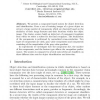Free Online Productivity Tools
i2Speak
i2Symbol
i2OCR
iTex2Img
iWeb2Print
iWeb2Shot
i2Type
iPdf2Split
iPdf2Merge
i2Bopomofo
i2Arabic
i2Style
i2Image
i2PDF
iLatex2Rtf
Sci2ools
CLOR
2006
2006
Components for Object Detection and Identification
We present a component-based system for object detection and identification. From a set of training images of a given object we extract a large number of components which are clustered based on the similarity of their image features and their locations within the object image. The cluster centers build an initial set of component templates from which we select a subset for the final recognizer. The localization of the components is performed by normalized cross-correlation. Two types of components are used, gray value components and components consisting of the magnitudes of the gray value gradient. In experiments we investigate how the component size, the number of the components, and the feature type affects the recognition performance. The system is compared to several state-of-the-art classifiers on three different data sets for object identification and detection.
| Added | 20 Aug 2010 |
| Updated | 20 Aug 2010 |
| Type | Conference |
| Year | 2006 |
| Where | CLOR |
| Authors | Bernd Heisele, Ivaylo Riskov, Christian Morgenstern |
Comments (0)

